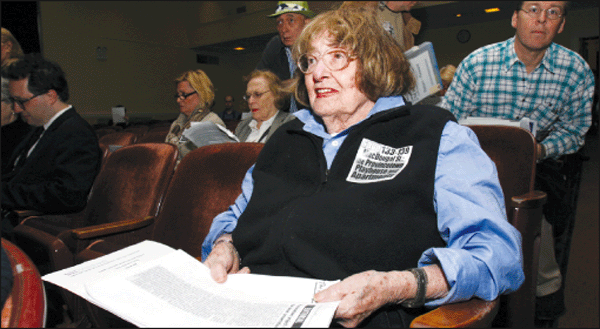By Albert Amateau
New York University’s revised plan to demolish and redevelop the four buildings where the Provincetown Playhouse is located provoked arguments among theater people, conflict among N.Y.U. faculty and opposition from preservation advocates last week.
Preservationists at the May 28 Commun-ity Board 2 Institutions Committee hearing were not satisfied that the proposal also called for saving the entrance, the structural walls and some of the furnishings of the famous little theater where the plays of Eugene O’Neill debuted in the second decade of the 20th century.
And although the proposed replacement of the current building, 133 to 139 MacDougal St., is of modest size and would not be as large as N.Y.U. has the right to build under current zoning, preservation advocates demanded that the existing building be saved and adapted for reuse.
“These buildings are incredibly historic,” said Andrew Berman, director of the Greenwich Village Society for Historic Preservation. “They are the center of what made Greenwich Village what it is.”
“If you knock it down, it can never be replaced,” said actor John Leguizamo. “N.Y.U. has a duty to this neighborhood and to your school to keep these buildings and the theater,” said Leguizamo.
The row of tenements where Susan Glaspell and George Cram Cook brought O’Neill, John Reed and other radical bohemians together 90 years ago no longer looks the way it did in 1914-1918. Successive reconstructions, including major changes in 1941, have made the row look like a single four-story building with one common brick facade.
Indeed, the Landmarks Preservation Commission has refused to consider the MacDougal St. buildings for designation on the grounds that the alternations removed their historical character. But the buildings are within the proposed South Village Historic District, which is under preliminary review by L.P.C. staff.
Berman noted that, in a 1998 renovation, N.Y.U. “destroyed key historic elements of the original theater, including a dome of the stage designed by George Cram Cook.” He called for those elements to be restored as much as possible to the theater.
The proposed new building would be five stories tall but only 4 feet taller than the existing building, except for a one-story penthouse that would be set back and only partly visible from the street.
New York University Law School, which owns 133-139 MacDougal St., originally proposed building an eight-story building on the site, but agreed to the revised plan when the university gave the law school the use of 22 Washington Square North. The Law School leases the theater to the N.Y.U. Steinhardt School of Education, which holds classes and student theater productions in the historic space.
Alicia Hurley, N.Y.U. associate vice president for government and community affairs, said the university intends to build a better, more useable theater while keeping the theater’s original four walls, ceiling and stage. Some of the current seats, dating to the 1920s, will be restored and reinstalled in the theater, she said.
Mary Brabeck, dean of Steinhardt’s music and performance arts education programs, said the school uses the theater for classes, conducts rehearsals and performances and for two months devotes the theater to the O’Neill at Yale program of readings, performances and other events related to the O’Neill legacy.
Responding to Berman’s observation that the theater appears closed at night, Joe Salvatore, a Steinhardt teacher, said there are classes there all day.
“If you find the doors locked at night, it’s because we’re in there,” added Randy Susevich, Steinhardt’s technical director of the playhouse.
But James Lawson, director of the Manhattan Theater Source, a 55-seat theater on MacDougal St. near Eighth St., said theater space in the city is shrinking and that N.Y.U. should make the Provincetown Playhouse available to small Off-Off-Broadway theater groups.
Bob Vorlicky, a teacher in N.Y.U. Tisch School of the Arts’ Institute of Performing Arts, said he has tried but failed to book space in Provincetown Playhouse for a Tisch performance.
Sharon Friedman, a teacher in N.Y.U.’s Gallatin School and a member of the Susan Glaspell Society, called on the university to make Provincetown Playhouse available for programs that honor the legacy of the theater’s founders.
A Steinhardt School analysis of its use of the Provincetown Playhouse shows that from June 2007 to May 2008 maintenance and stage work took 24 percent of the theater’s operating hours. However, a director of a small theater group said that in most small theaters, maintenance and stage work takes up only about 7 percent of the operating time.
Nevertheless, George Forbes, president of the League of Off-Broadway Theaters and Producers, noted that the Playhouse has seats for 135 people. To be economically viable, Provincetown Playhouse would have to be upgraded and made bigger, Forbes said.
But Leonard Jacobs, national theater editor of the weekly Backstage, made an impassioned plea for making Provincetown available for nonprofit theater groups.
“I’m worried what might end up if we countenance the destruction of this building,” said Simeon Bankoff, director the Historic Districts Council. “It is in the heart of the proposed South Village Historic District and its destruction is at the heart of what we want to save.”
Several people at the May 28 forum recalled the battle over the N.Y.U. Law School project eight years ago that involved the demolition of Judson Church House on Thompson St. near W. Third St. and an adjacent building on W. Third St. where Edgar Allan Poe lived for a time in the 1830s. The “Poe House” was memorialized in part of the facade of the new Law School building, and for preservationists, the replica facade stands as a monument to what should not be done in the name of historic preservation.
































